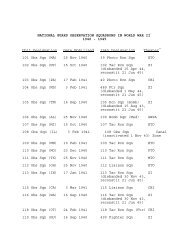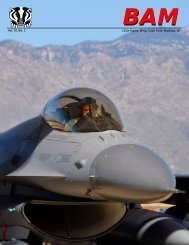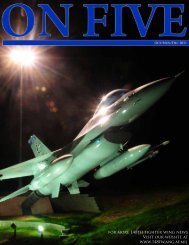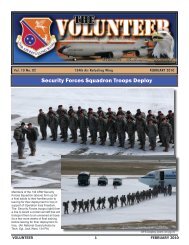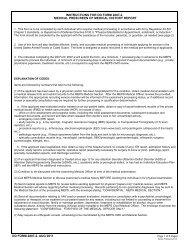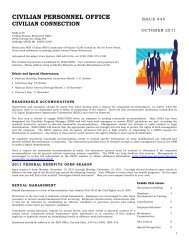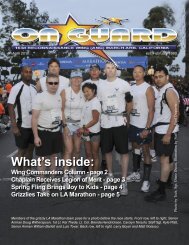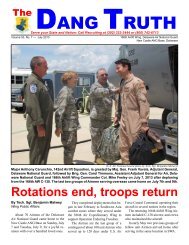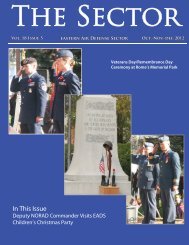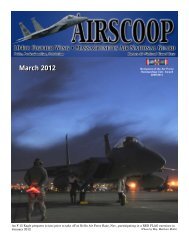APRIL <strong>2011</strong>AIRSCOOPPAGE 8WSEP exercise <strong>2011</strong>By Staff Sgt. Matthew Benedetti, Public Affairs JournalistMembers of the 104 th <strong>Fighter</strong><strong>Wing</strong> are deploying to Tyndall AFBin Florida for two weeks in <strong>April</strong> forthe Weapons System EvaluationProgram (WSEP). This will be thefirst opportunity for the 104 thmembers to test the Operations andMaintenance system while deployingF-15s with people and cargo whileloading live munitions with the F-15s.<strong>Air</strong> Force Target Drone (File photo)During the upcoming deployment,F-15s will employ air-to-air missilesagainst real world targets.With many pilots still intransition from the previous A-10 air to ground mission, onlyabout half of all 104 th F-15pilots have ever employed anair-to-air missile. “This is acritical combat skill for all F-15pilots to be able to maneuvertheir aircraft to an acceptableWeapons Engagement Zoneand employ missiles,” saidMajor Shane Nagatani, OIC ofthe mission.The capacity at Barnes is limitedand this training environment inFlorida allows 104 th pilots to includeLarge Force Exercises. “I havecoordinated Large Force Exerciseswhile we are deployed to TyndallAFB, which will include both fourthgeneration F-15s/F-16s and fifthgeneration F-22s,” said Maj,Nagatani.“These training opportunities arerarely seen for the 104 th , unless weare deployed,” added Maj, Nagatani.OPSEC and unclassified informationBy Staff Sgt. Matthew Benedetti, Public Affairs JournalistAs the <strong>Wing</strong> Operations Security(OPSEC) Program Manager for the104 th , Capt. Glenn Milliken’s chiefconcern is monitoring unclassifiedinformation originating from thebase. Although by itself a piece ofunclassified information may be innocuous,combined with anothersource, a potential threat mayemerge. Whether it is a flight roster,maintenance related data or a Facebookposting, Milliken’s focus is ensuringthat unclassified informationis handled in a prudent manner.“I worry about an adversary puttingthe pieces of the puzzle together,”he said. “If information isused collectively, it can paint a goodpicture of what we do.”As the chair of the OPSEC workinggroup, he takes an adversarialperspective in order to detect vulnerabilities.A potential enemy will tryto determine -Who we are, What wedo, and What limitations exist.He urges members to understandthe technical limitations pertainingto social media. Facebook for example,has a feature that allows an interestedparty to locate the geographicarea where a user is loggedin. For a deployed military member,this information could have direramifications and could possibly compromisethe mission of their unit.Milliken’s advice to unit membersrelative to OPSEC is to always becognizant of what you are communicating.He advises, “Ask yourselfwhether you would hand the informationto the enemy.”Master Sgt. Yasser Menwer, thesecurity manager here at Barnes,cautions members on their collectivesecurity responsibility. “What makesus targets is the fact that sometimeswe do not realize that saying just alittle bit, can many times be toomuch,” he said.“We also tend to let our guarddown because we are not in the desert.We may become very complacentbecause we are “just” a <strong>Guard</strong>base. The fact of the matter is thatwith our <strong>Air</strong> Sovereignty Alert mission,we become bigger targets insteadof less,” said Menwer.
APRIL <strong>2011</strong>AIRSCOOPPAGE 9It’s time to …. Get involvedBy Master Sgt. Dominique Chapman, Victim Advocate<strong>April</strong> is the month that most of ourfamilies celebrate Easter, but if you arenot aware, the month of <strong>April</strong> was alsochosen as Sexual Assault AwarenessMonth (SAAM). The goal of SAAM is toraise public awareness about sexual violenceand to educate communities andindividuals on how to prevent sexualviolence.As your reading this, thinkabout your Bystander InterventionTraining and if you have not attendedthis training yet, don’tworry, you will at some point inyour military career. BystanderIntervention is about getting involvedand when I speak about involvement Idon’t mean digging into other people’sbusiness. I am talking about pure commonsense, using your situational awarenessskills.We have all read the stories or seenthem on the evening news each and everyday. In Richmond, CA a 15-year-old girlwas gang raped and beaten in a schoolyardduring a homecoming dance. Asmany as 20 people witnessed the assaultwhich lasted almost 2 hours. Back inFebruary <strong>2011</strong> Lara Logan, a CBS newsreporter, was sexually assaulted by amob while covering a story in Egypt. Shewould not have survived if a group ofEgyptian woman did not throw themselveson top of her to protect her fromthe crowd. In October of 2009, a maleArmy pilot was sexually assaulted byanother male while recovering from hisinjuries in the hospital. On 3 March2007, a 17 year old girl was being gangraped at a party thrown by the De Anzabaseball team in Cupertion, CA. Threegirls from the soccer team who were atthe party witnessed the act. They brokedown the door to the bedroom and calledthe police. Not all these stories involveda bystander who intervened, but somedid, those women did. They made achoice right then and there to get involved.Situations such as the above mightnot always be so obvious, you could beanywhere, at a party with friends, atwork, at a buddies house, and see a situationthat might not feel right to you. Butthe question is, “why don’t we get involved”?There are so many reasons;what if you do get involved and someonehates you for it? What if your buddy tellsyou you’re “cock blocking” him? What ifyou wind up becoming the victim yourself?Sometimes looking the other wayand pretending it’s not happeningis the easier route. If youdon’t know the person, especiallyin teenage points of view, it ishard to see that person as real toyou, you don’t know them, and asfar as you are concerned, thatindividual is responsible forthemselves. Sometimes the more peoplethat are present to witness an event, theless each individual feels personally responsiblefor doing something, someoneelse will take care of it, right?We have all heard this before, that 15year old girl in the story above couldhave been your daughter or sister, thatman could have been your brother.These stories and people are real andthey affect real lives. Drew Carberry, adirector at the <strong>National</strong> Council on CrimePrevention says that “If you are in acrowd and you look and see that everyoneis doing nothing, then doing nothing becomesthe norm.ANG receives new controlled spending account for government travelBy <strong>Air</strong>man 1st Class Bonnie Harper, Public Affairs JournalistThe <strong>Air</strong> <strong>National</strong> <strong>Guard</strong> will beginreplacing the current governmenttravel cards on <strong>April</strong> 1 with a newcontrolled spending account debitcard.The switch is being made due tothe extensive and costly managementtasks linked with the GTC,according to <strong>National</strong> <strong>Guard</strong> Bureauofficials.“Although the GTC and CSA arevery similar there are some significantimprovements that make the CSA amission driven travel card,” said MasterSgt. Don Hickman, the agency projectcoordinator here at Barnes.The new CSA card is the perfecttravel product because it can be used byeveryone. The GTC requires a creditcheck, which results in only 75 percent of<strong>Air</strong> Force travelers qualifying to use thecard. There is no credit check involvedwith the CSA, allowing 100 percent participation,Hickman said.The new CSA card comes with a zerobalance. Funds are automatically transferredonto individual CSA cards as soonas travel orders are approved.All personnel that currently hold aGTC will be automatically enrolled intothe CSA program if they have a zero balanceon their card, and no approved ordersfor future travel. Once auto enrollmentin the new program has occurred,the GTC will be cancelled immediately.Those who do not hold a GTC can applyfor a CSA card beginning <strong>April</strong> 1, Hickmansaid.In preparation for this switch, orderlyrooms have been asked to confirm mailingand email addresses for all unit members.This necessary information willallow Citibank to mail the new cards toall personnel, and to send email notificationswhen money is added to individuals’cards, Hickman said.For more information, please visitwww.airforcetravelcard.transactionservic





